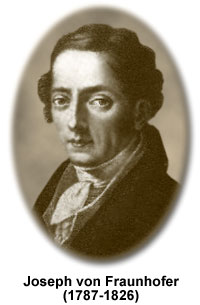Joseph von Fraunhofer
(1787-1826)

Joseph von Fraunhofer was the youngest of a poor glass grinder's ten children and was orphaned at the age of 11. He did not receive the luxury of a formal education, but was apprenticed to a Munich mirror maker and lens grinder. In 1801, an accident occurred that almost cost von Fraunhofer his life, but ultimately worked out to his great benefit. The building that he was working in collapsed and buried him alive for several hours. His dramatic rescue caught the attention of the court prince, as well as Joseph Utzschneider, a politician with an interest in optics. Von Fraunhofer's royal patron bestowed a fair sum of money upon him, which he used to buy himself out of his apprenticeship and to purchase a glass cutting and polishing machine. Utzschneider, however, gave friendship and books to the boy, which fueled his self-education.
Employed at a Munich workshop that made scientific instruments, which was partially owned by Utzschneider, von Fraunhofer continued to develop his skills in optics. During this period, he analyzed lens making, developed new grinding techniques, and invented a polishing machine that rendered lens making more akin to an industrial manufacturing process. Von Fraunhofer also improved the composition of the polishing material and cement used to assemble lenses and introduced the use of an unaltered sheet of glass as a test device to check the shape and concentricity of polished lens surfaces.
Later, at Utzschneider's new glass melting workshop, von Fraunhofer discovered that the quality of glass was a major variable in the process of obtaining perfect optics. Under the tutelage of a Swiss glassmaker, he developed new types of glass suited to making bigger and better optics. By 1809, von Fraunhofer was made partner of the firm, assuming many of the business responsibilities. For a time, he became primarily engaged in designing achromatic objective lenses for telescopes that required the accurate determination of the refractive indices of the optical glasses. Several years later, in 1817, he finally succeeded. With only minor modifications, his design continues to be used in microscopes and other fine optics.
In 1813, von Fraunhofer accomplished what is often considered his greatest achievement. He independently rediscovered William Hyde Wollaston's dark lines in the solar spectrum, which are now known as Fraunhofer lines. He described a great number of the 500 or so lines he could see using self-designed instruments, labeling those most prominent with letters, a form of nomenclature that is still in favor. Fraunhofer lines would eventually be used to reveal the chemical composition of the sun's atmosphere.
Von Fraunhofer is also renowned for building the first diffraction grating, made up of 260 close parallel wires, in 1821. The rudimentary gratings were soon upgraded, possessing up to 10,000 parallel lines per inch, and were ruled by a specially constructed dividing engine. Von Fraunhofer was well versed in the mathematical wave theory of light and used the gratings to measure the wavelengths of specific colors and the dark lines in the solar spectrum. He also used them to develop the laws of diffraction.
The once uneducated apprentice advanced far from what might be expected from his humble beginnings. Von Fraunhofer was honored with membership to the Bavarian Academy of Sciences, given an honorary doctorate from the University of Erlangen, and is considered founder of the German optical industry. He taught at the University of Bavaria and was knighted in 1824. Von Fraunhofer may have achieved even greater heights if he had lived a longer life. However, the self made man contracted tuberculosis and died prematurely in 1826.
